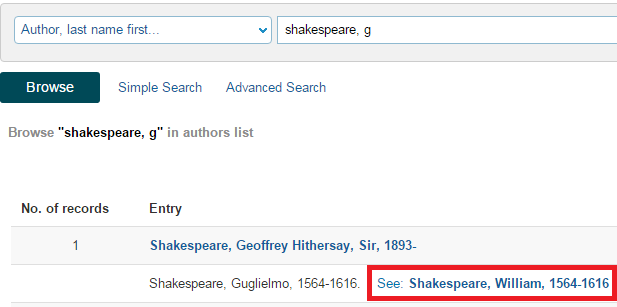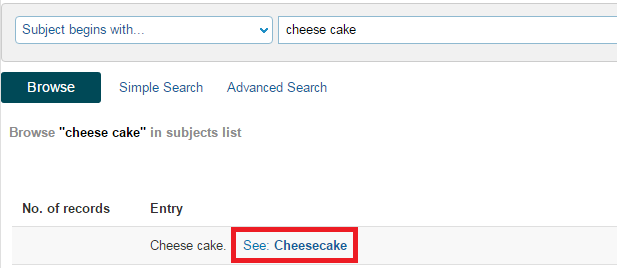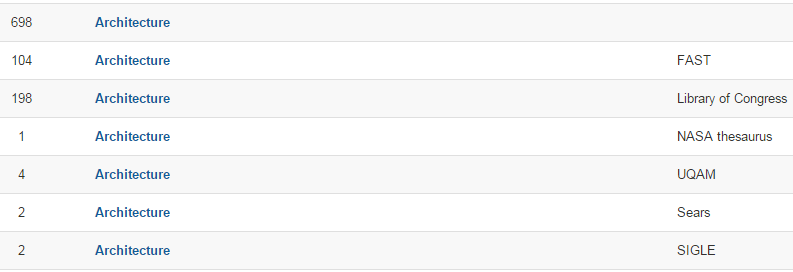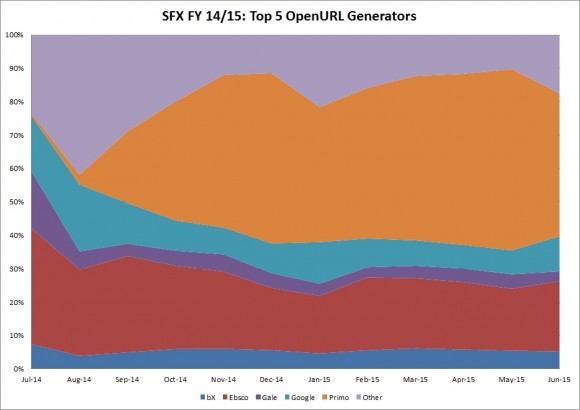Impact of Primo on SFX
A few weeks ago, we (OLS staff) discussed ways in which the impact of Primo on other systems and environments could be illustrated.
A good place to start with is SFX, since it’s so heavily involved in creating fulltext links in Primo. So one way to measure Primo’s impact on SFX is to count the number of OpenURLs generated by Primo (either through “View Online”, or through the menu under “Other Options”) and compare them to other providers/generators of OpenURLs.
In FY 14/15, the top 5 providers were Primo, bX, Ebsco, Google, and Gale (For the remaining providers, the numbers drop significantly). Here’s a table with the number of OpenURLs generated each month by each provider:
bX Ebsco Gale Google Primo Other July-14 3052 14185 6990 6847 308 9672 August-14 1147 7512 1571 5821 859 12186 September-14 4477 25903 3289 10940 19302 25912 October-14 10651 44538 8009 16150 63698 35567 November-14 12934 49530 11050 17189 97932 25718 December-14 9506 31664 7530 15206 86557 19483 January-15 2583 9595 2030 6925 22495 12034 February-15 6194 24143 3317 9526 49877 17518 March-15 12127 41397 7257 15032 96998 24205 April-15 11756 40696 8220 14330 103400 23534 May-15 10033 33960 7951 13107 99598 18721 June-15 3494 14075 1955 7026 28637 11702 TOTAL OpenURLs: 1538333
I thought the best way to show the behavior over time is to use an area chart, because it shows how values (# of requests) change over time for different categories (OpenURL “generators”):
Since it’s implementation at the end of August 2014, Primo has quickly taken over a large share of the OpenURLs resolved by SFX, at a small expense to the other providers, but not by much. It actually looks as if the percentage of requests for the other main providers has remained relatively stable
The same chart in absolute numbers looks like this:
So it looks as if Primo has taken over a large share of the OpenURL requests, but not so much by taking them “away” from other providers but by simply increasing the number of OpenURLs.
The total number of SFX requests for FY13/14 was about 1.1 million (1,107,169). In the past FY, this increased by almost 40% to 1.5 million (1,538,333). And of these, 670K (669661) came from Primo.
Observations:
- In FY 14/15, Primo was responsible for over 40% of OpenURL requests, i.e. SFX menus
- It reached this number very quickly, within about 2 months of going live
- It simply increased the number of requests, and did not diminish the contribution of other vendors
- Given the impact on SFX, the impact on e-resource usage (search sessions, etc.) should be significant as well
Why Does OneSearch Say We Have the Electronic Book?
We’re finding that the Merck Manual is in our results as an e-resource but we only have it in print. Why does this happen?
OneSearch interprets cataloging quite literally.
In this case, the MARC record contains this 856 field (full record):
85641 $uhttp://www.merck.com/pubs/mmanual%5Fhome2/
The second indicator has a mission-critical role (MARC 856 field @ LOC)
- # – No information provided
- 0 – Resource
- 1 – Version of resource
- 2 – Related resource
- 8 – No display constant generated
OneSearch interprets all 2nd indicator values EXCEPT 2 as a version of the e-resource. Since, in the case above, the 2nd indicator = 1, OneSearch reports that the e-resource is available.
If a link is NOT to an actual e-resource, but links to related content, the 2nd indicator should be a 2.
There is one exception. Sometimes tables of contents and other materials are classified with 2nd indicator = 1, that is, a version of the resource. In that case, in order to avoid OneSearch reporting that the e-resource is owned, both of the following must be true:
- at least one of these note subfields must appear: $3, $y, or $z
- one of these note subfields must contain one of the following texts:
- Table of contents (or Inhaltsverzeichnis or Table des matières or Indholdsfortegnelse)
- Sample text
- Publisher description (or Klappentext)
- Book review
- Contributor biographical information
The most common cataloging for these at CUNY
- 85641$3 for “Table of contents” and “Sample text” notes
- 85642$3 for “Publisher description” and “Book review” notes
Before reporting this type of issue to OLS, please check the record metadata with your cataloger.
If the reason for the problem is not obvious from the cataloging and a work order is opened, please copy the 856 field into the work order.
This post was originally published on 29 April 2015. We updated it on 18 August 2015 to reflect the latest information regarding the texts which do not indicate an e-book (for example, klappentext).
New in OneSearch: Enriched Browse
 OneSearch’s Browse now has a new feature: “See” references!
OneSearch’s Browse now has a new feature: “See” references!
When browsing by either Author or Subject, the results now link to the preferred term from the non-preferred term.
For example,
- when browsing the author “shakespeare, g,” OneSearch shows that “Shakespeare, William, 1564-1616” is the preferred form to “Guglielmo” and provides a link to that preferred author:

- when browsing the subject “cheese cake,” OneSearch shows that “Cheesecake” is the preferred form:

Note that multiple authority sources are currently present in our search results. In OneSearch, the source of an authority often appears in the right column of browse results. The wealth of resources can lead to duplication of subject terms (example below):

This is not new behavior. We have made some improvements and are continuing to work on this issue. In the near future, we plan to remove all subject authority sources except:
0 – Library of Congress Subject Headings
1 – LC subject headings for children’s literature
2 – Medical Subject Heading



